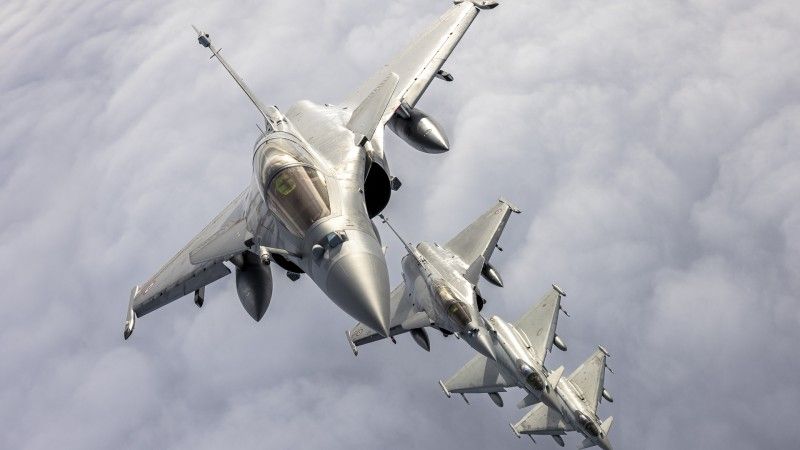France: Too Few Warheads for Effective Nuclear Deterrence?

Photo. NATO Air Command
France currently possesses 290 nuclear warheads, making it one of the smallest arsenals among the permanent members of the UN Security Council. In the face of the current threat from the Russian Federation—which explicitly fears the expansion of NATO’s nuclear umbrella—the question arises whether this French capability is sufficient not only for national defence but also for potentially supporting European allies within a broader deterrence strategy.
France’s nuclear deterrence strategy, continuously developed since the 1960s, is based on two pillars: sea and air. The lack of a land component means the country has abandoned the classical nuclear triad. Instead, France has prioritised mobility, secrecy, and political-operational independence. Its entire nuclear arsenal remains outside NATO structures and under the sole control of the President of the Republic.
France maintains around 290 nuclear warheads as it adheres to a doctrine of minimum but credible deterrence—designed to inflict massive damage on an adversary without needing to match the arsenals of the US or Russia. Its deterrent forces are entirely independent, and further expansion would not only entail immense costs but could also undermine the consistently implemented strategy of gradual and proportional use of force.
However, in the context of a possible extension of the French nuclear umbrella to cover the whole of Europe—as suggested by President Emmanuel Macron—the figure of 290 warheads may prove insufficient, especially if it is intended to cover broader strategic interests. This, in turn, could necessitate a review of the current doctrine and operational capabilities.
What are France’s capabilities?
The core of France’s deterrent remains the Force Océanique Stratégique—four Le Triomphant—class submarines, each armed with 16 M51 ballistic missiles. These missiles carry TN-75 warheads with multiple independently targetable re-entry vehicles (MIRVs). At least one submarine is continuously on combat patrol while submerged, ensuring a credible second-strike capability, even in the event of a surprise attack on France. Work is already underway on a new generation of submarines, due to enter service around 2035, alongside the modernisation of the M51 missiles to the M51.3 version, which features improved range and accuracy.
The air component is based on Rafale B and Rafale M aircraft, armed with ASMPA cruise missiles. With a current range exceeding 500 km—and set to grow significantly with the introduction of the ASMPA-R and ASN4G variants—the air forces remain a flexible and responsive element of deterrence. Notably, the air base at Luxeuil-les-Bains, where Ukrainian Mirage pilots are being trained, will become the first unit equipped with the new generation of Rafale aircraft carrying hypersonic weapons.
Nuclear exercises such as Operation Poker, conducted quarterly, simulate full-scale deterrence operations, including nuclear weapon use. These take place under conditions of strategic threat to Paris’s interests, including electronic warfare and communications disruption scenarios. It was during one of these exercises that President Emmanuel Macron suggested the possible extension of the French deterrent umbrella to the European level—a notion that feeds into the broader debate about the future of collective security within the European Union, including for countries such as Poland.
Increasing capability
France does not plan to expand its arsenal but is focusing instead on modernising its infrastructure and delivery systems. In 2024 alone, €6.6 billion—14% of the defence budget—was allocated to nuclear deterrence. Investments include new submarines, upgrades to the M51 and ASMPA missiles, and base infrastructure developments, such as at Luxeuil, which will become the main operational hub for the next-generation air force by 2035.
Paris does not participate in NATO’s „nuclear sharing” programme, but it is increasingly open to involving partners—including Poland—in deterrence-related exercises. The goal is not only interoperability but also to demonstrate the readiness and political credibility of the French strategy. Although the term „nuclear umbrella” is often avoided, alternative approaches are being considered—such as the deployment of an air component with nuclear weapons as a deterrent, particularly in the context of NATO’s eastern flank.
French deterrence strategy is no longer dogmatic and is evolving. Macron now argues that it must be adapted to the global environment, as nuclear weapons remain a tool of geopolitical influence. While Russia, China, and the US are expanding their arsenals, France is in no rush to increase its warhead count, opting instead for continuous modernisation. Under its doctrine, nuclear weapons would only be used in the face of an actual threat to national interests—interests which may increasingly extend to NATO’s eastern flank.
290 warheads may seem modest, but France’s capabilities and weapon systems are both sufficient and modern. The key factor—especially for a country like Poland—is that when the moment comes to demonstrate force and capability, American, French, and ideally British elements of deterrence are present to compel the Russian Federation to retreat. France’s 290 warheads are fully adequate for the current theatre of nuclear deterrence competition in which the nuclear-armed powers operate.



